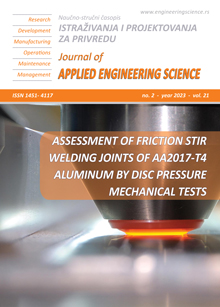EXPOSURE OF THE LOAD CAPACITY OF THE RC STRUCTURAL SYSTEM UNDER CORROSION DAMAGE TO COLUMNS
Abstract
A number of accidents, such as the partial collapse of a residential building in Surfside on June 24, 2021, or the collapse of the roof structure of Basmanny Market in Moscow on February 23, 2006, show that aggressive medium impacts on reinforced concrete structures lead over time to a decrease in their strength resistance resource under accidental impacts. At the same time, the investigations in this field mainly deal with structural members under bending, while eccentrically compressed and corroded reinforced concrete members have been considered either in particular aspects or the obtained solutions are rather complicated for their practical application. In this regard, the purpose of the article was to assess the influence of the corroded depth on the load capacity of eccentrically compressed reinforced concrete columns of structural frames, as well as to predict the time of exhaustion of their load capacity under constant serviceable loads. The paper adopted the phenomenological model of V.M. Bondarenko to take into account long-term corrosion processes. It had been established that an increase in the corroded depth leads to a decrease in the load capacity of eccentrically compressed reinforced concrete members due to a decrease in the effective cross-sectional depth and effective slenderness ratio. The relative depth of the destroyed concrete varies depending on the current stress-strain state of the structural member. The time to reach the critical corroded depth depends significantly on the parameters of aggressive medium and the stress-strain state of the structural member and may differ by several times when implementing avalanche or descending damage kinetics.
References
Kong, X., Smyl, D. (2022) Investigation of the condominium building collapse in Surfside, Florida: A video feature tracking approach. Structures, vol. 43, 533–545, DOI: 10.1016/j.istruc.2022.06.009
Nazarov, Yu.V., Zhuk, Yu.N., Simbirkin, V.N., Egorov, M.I. (2007) Basmanny Market: Analysis of Design Solutions and Possible Mechanisms of Building Destruction. Structural Mechanics and Analysis of Constructions, vol. 211, no. 2, 49-55.
Xiao, J., Long, X., Qu, W., Li, L., Jiang, H., Zhong, Z. (2022) Influence of sulfuric acid corrosion on concrete stress–strain relationship under uniaxial compression. Measurement, vol. 187. DOI: 10.1016/j.measurement.2021.110318
Zhou, C., Zhu, Zh., Wang, Zh., Qiu, H. (2018) Deterioration of concrete fracture toughness and elastic modulus under simulated acid-sulfate environment. Constr Build Mater., vol. 176, 490–499. DOI: 10.1016/j.conbuildmat.2018.05.049
Yang, D., Yan, Ch., Liu, Sh., Zhang, J., Hu, Zh. (2019) Stress-strain constitutive model of concrete corroded by saline soil under uniaxial compression. Constr Build Mater., vol. 213, 665–674. DOI: 10.1016/j.conbuildmat.2019.03.153
Wen, Q.Q., Chen M.Ch. (2021) Study on the nonlinear performance degradation of reinforced concrete beam under chloride ion corrosion. Eng Fail Anal., vol. 124. DOI: 10.1016/j.engfailanal.2021.105310
Bondarenko, V.M., Klyueva N.V. (2008) Analysis of structures that change the design scheme due to corrosion damage. News of higher educational institutions. Construction, vol. 589, no. 1, 4–12.
Selyaev, V.P., Selyaev, P.V., Alimov, M.F., Sorokin, E.V. (2017) Estimation of residual resources of reinforced concrete bending elements subjected to the action of chloride corrosion. Building and Reconstruction, vol. 74, no. 6, 49-58. https://construction.elpub.ru/jour/article/view/83, date of access 20.06.2022
Smolyago, G.A., Dronov, V.I., Dronov, A.V., Merkulov, S.I. (2014) Investigation of influence of defects of reinforced concrete structures on corrosion processes of steel reinforcement. Industrial and Civil Engineering, no. 12, 25-27.
Popov, D.S. (2022) Experimental studies of dynamic properties of corrosion-damaged compressed reinforced concrete elements. Building and reconstruction, vol. 100, no. 2, 55–64. DOI: 10.33979/2073-7416-2022-100-2-55-64
Tamrazyan, A.G., Popov, D.S., Ubysz, A. (2020) To the dynamically loaded reinforced-concrete elements’ calculation in the absence of adhesion between concrete and reinforcement. IOP Conf Ser Mater Sci Eng., vol. 913, 022012. DOI: 10.1088/1757-899X/913/2/022012
Liu, M., Jin, L., Zhang, R., Chen, F., Du, X. (2022) Combined effect of corrosion and strain rate on the bond behavior: A two-stage simulation. Int J Mech Sci., vol. 227. 10.1016/j.ijmecsci.2022.107438
Ma, J., Yu, L., Li, B., Yu, B. (2022) Stress–strain model for confined concrete in rectangular columns with corroded transverse reinforcement. Eng Struct. vol. 267. DOI: 10.1016/j.engstruct.2022.114710
Jeon, C.H., Lee, J.B., Lon, S., Shim, Ch.S. (2019) Equivalent material model of corroded prestressing steel strand. Journal of Materials Research and Technology, vol. 8, no. 2, 2450–2460. DOI: 10.1016/j.jmrt.2019.02.010
Bondarenko, V.M. (2014) Exposure of the stability of reinforced concrete columns operated in an aggressive environment. Structural Mechanics and Analysis of Constructions, no. 3, 27-34.
Tamrazyan, A., Alekseytsev, A.V. (2022) Optimization of reinforced concrete beams under local mechanical and corrosive damage. Engineering Optimization. DOI: 10.1080/0305215X.2022.2134356
Li, B., Li, S., Zhang, G., Ying, H., Xia, Q., Liu, S. (2023) Grading assessment of steel bar corrosion in concrete structures based on naive Bayesian model and spontaneous magnetic flux leakage effect. J. Eng. Appl. Sci., vol. 70, 3. https://doi.org/10.1186/s44147-022-00170-9
He, S., Cao, Z., Ma, J., Zeng, S., Li, P., Wang, H. (2021) Influence of Corrosion and Fatigue on the Bending Performances of Damaged Concrete Beams. Advances in Civil Engineering, art. no. 6693224. DOI: 10.1155/2021/6693224
SP 63.13330.2018 (2018) "SNiP 52-01-2003 Concrete and reinforced concrete structures. General provisions. https://docs.cntd.ru/document/554403082, date of access 20.06.2022
BS EN 1992-1-1. (2004). Eurocode 2: Design of concrete structures - Part 1-1 : General rules and rules for buildings. British Standards Institution, https://www.phd.eng.br/wp-content/uploads/2015/12/en.1992.1.1.2004.pdf, date of access 20.06.2022

